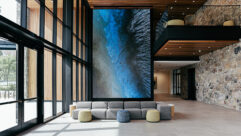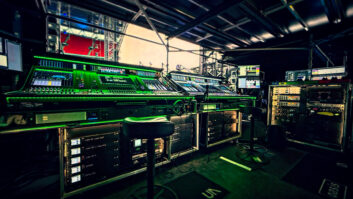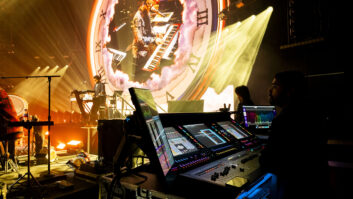Westminster Abbey Phase II
Mar 1, 1996 12:00 PM,
By Keith Clark
Editor’s note: The Westminster Abbey sound-system refurbishment project had originally been programmed to run from October 1993 through September 1996. The technical details of the installation were covered in our January 1995 issue.
When Westminster Abbey decided to update its speech-reinforcement system in 1994, the Abbey and DRV, Cornwall, England, the sound-system installer, came up with a time line of specific phases. Our initial thoughts were that each stage could be completed in a relatively short period of time with minimal disruption to the Abbey. Not having undertaken work in the Abbey before, we were unaware of the strange time difference that occurs once you enter its hallowed portals. Working in the Abbey has many special requirements, and with hindsight you can see why the estimate of three years to install 58 loudspeakers and a control rack was not unreasonable.
The project had originally been divided into three contract phases. Phase one included the replacement of the central equipment racks and control panels, upgrade for emergency use, including standby power facilities, and the installation and wiring for the nave aisle and transept loudspeakers. Phase two was to include replacement or relocation of the existing loudspeakers and wiring, the provision of additional loudspeakers, replacement or relocation of the microphone outlets and replacement of existing microphones, and the provision of radio microphones. Phase three was to include the provision of additional audio frequency loop systems and the replacement of the east end loudspeakers and the Henry VII chapel system.
Special conditionsAll projects have their own idiosyncrasies. We have worked on a number of projects where special considerations, such as the age of fabric of the building, cause problems. However, none of these projects has ever involved the special working conditions we encountered in the Abbey.From end to end, the Abbey is nearly 656 feet (200 m) long and has 136 steps up a small spiral staircase to the first level (the triforium). This level is 59 feet (18 m) above the ground floor, and the spiral staircase provides the only access route. The stairs are positioned in the southwest corner of the Abbey’s Poets Corner; from there one has access to all four corners of the triforium level. From a standing start it takes approximately 12 minutes to get from the rack room in the organ loft to the farthest point of the triforium.
The triforium level is fairly spacious and covers the area around the sides of the Abbey where the first-floor ceiling forms vaulted compartments. All tools and equipment too long or too heavy to be carried up the spiral staircase had to be winched up to the triforium level with a manual pulley.Because of the age of the stonework, no drilling or nail fixings were allowed. All cables had to be tied or glued into position with stone-colored ties or glue. The cable used was specially jacketed in beige to match the ancient stonework.
Each of the loudspeakers was installed at a height of approximately 9.8 feet (3 m) from the floor, some 49 feet (15 m) below the triforium. The loudspeakers were covered in a special beige-colored sock, which ensured the minimum visual intrusion. Each loudspeaker has an individual cable feed and amplifier channel to allow variable delay settings when used with different microphone positions. It was not possible to take the loudspeaker cables under the solid stone floor, so multicore cables were run from the rack room up through the organ loft to distribution boxes on either side of the triforium. From these distribution boxes individual cables were run on new cable trays through the roof of the triforium and down each pillar.
Installing on the flyOnce the cable had left the cable tray, only glue could be used. Ladders were considered too dangerous to use with the public below, and the installation of scaffolding was not possible. A cherry picker could only be used in limited areas where the floor was considered strong enough. Therefore, the majority of cables could only be installed by absailing down each of the pillars and gluing the cable into the pillar coin.When the Abbey was constructed, absailing was not even a minority sport, and the fixing of ropes and belaying lines proved difficult on almost every occasion. Absailing had to be undertaken with all ropes shrouded where they touched the stonework, and absailers had to wear soft-soled shoes to minimize damage to the pillars on their descents.
The Abbey is a very reverberant space. RT60 is more than eight seconds, and any sound more than a whisper could be heard by a considerable number of people. In a short time, this reverberation seemed to limit the descriptive powers of the engineers on site.
The majority of work was done during weekdays while the Abbey was open and the general public occupied the areas below the cable installation works. An added complication was that every hour, five minutes were taken up with the hourly prayer. We were not permitted to work during the periods of prayer and services, and all work had to be timed such that any period of work lasted a maximum of 45 minutes to allow engineers time to clean up. Add this to the morning Westminster School services, evensong and special lunch-time services, and a considerable period of every day was unavailable for working.Regardless of all this, the project was one of the most challenging and enjoyable we have had the pleasure of being involved with.
Everyone considered the final result to be a great technical success, and the project achieved considerable praise from all who have had the opportunity of comparing the new and old systems.










